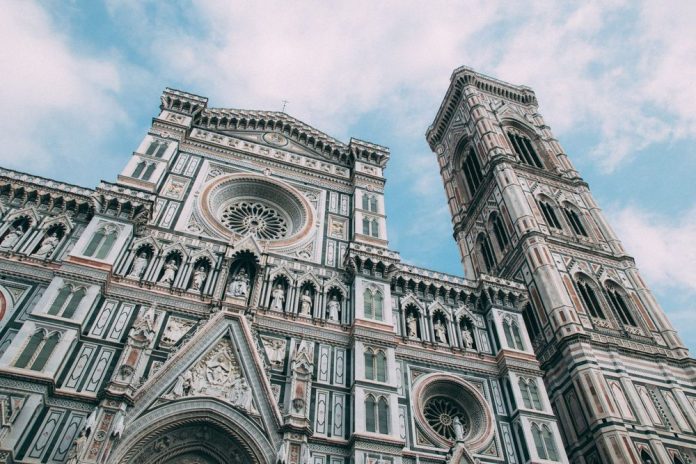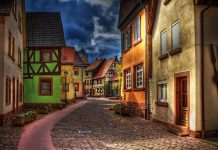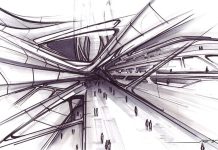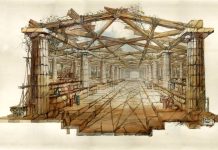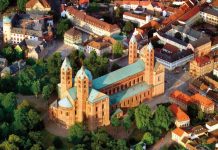The main types of buildings and structures are city and monastery cathedrals, municipal buildings, loggias, watchtowers and residential towers, palaces of the nobility, city
fountains.
- Orvieto (Umbria). Cathedral of the beginning of 1290, main facade 1310-1330, Lorenzo Maitani, Andrea Pisano, Andrea Orcagna. Completed in the 16th century . Palazzo del Capitano del Popolo (13th century).
- Assisi (Umbria). The church of the Franciscan monastery and the church of Santa Chiara (13th century).
- Perugia (Umbria). Cathedral of San Lorenzo (1345-1490). Palazzo Comunale (13th –
15th century). Fonte Maggiore (1278, Fra Bevignato, Niccolo and Giovanni Pisano).
San Gimignano (Tuscany) – “the city of seventy towers” (13th-14th centuries)
Siena (Tuscany). Cathedral (1220-1377, Giovanni Pisano?). Department in the interior –
Niccolo Pisano, 1266-1268. Palazzo Publico (1297-1310). Torre del Manjo
(“The Glutton”, 102 m, 1338-1348, brothers di Rinaldo). Frescoes in the interiors of the palazzo Publico works by A. Lorenzetti and S. Martini (14th century) with images of the city and condottiero Guidoriccio da Fallano. - Pisa (Tuscany). Cathedral Ensemble and Piazza dei Miracoli. Cathedral (11th-12th centuries, from 1063 master Baskoni). Baptistery (from 1153, Diotisalvi, 14th century, Giovanni Pisano; the span of the ceiling is 20 m, the pulpit in the interior is about 1260, Niccolo Pisano). Campanile (“Leaning Tower”) from 1173, Bonaccio Pisano, completed ca. 1301; the deviation from the vertical is 4.2 m.
- Mantua (Lombardy). Castle of San Giorgio for the Dukes of Gonzaga (1395-1406,
Bartolino da Novara).
Padua (Veneto). Basilica of San Antonio (del Santo), construction began in 1252.
Monument to the condottiero Gattamelata (Erasmo de Narni) by Donatello (1453).
Palazzo della Ragione (start of construction 1219, arcade 1306, hall 78.5 m long, span and height 27 m.). - Venice (the center of the Veneto region) on the shore of the lagoon of the Adriatic Sea. A system of channels (over 100), of which the longest is the Rio Grande (length 3700 m, width 40-70 m, depth no more than 5 m). The central ensemble of the city is St. Mark’s Square, Piazzetta, Molo Embankment. St. Mark’s Cathedral 829-832, rebuilt 1073-1095, facade finished in the 15th century; sculptures of horses 4-3 centuries BC, brought
from Constantinople in 1204; bell tower 888-1517, height 100 m, collapsed in
1902, restored in 1912. The Doge’s Palace was built from the 9th century, the southern building of the 14th century., the western building 1424-1442 by Giovanni and Bartolomeo Bon; the entrance to the Porta della Carta building 1438-1442 by the same authors; the eastern building 1483-1498 by A. Rizzo; courtyard facades from 1484, the staircase of Giants 1484-1501. - Florence (the center of the Tuscany region). Founded by the Romans. The second ring of walls is the boundary of the 11th and 12th centuries . The commune of the 12th century, power since 1138 at the college of consuls. 1250 – the victory of the Guelphs, the constitution, the establishment of the post of Capitano del Popolo. In the construction of the city towers (in the 13th century – up to 150), according to the constitution their height is limited to 25 m. 1260 – the return of the Ghibellines to power. In the 13th century. strengthening of workshops (in 1287 – 21 workshops, of which 7 senior, 5 middle and 9 junior). 1293 – new constitution. Created The Signoria is a council of nine, seven of which were chosen by the senior workshops, headed by “gonfaloniere of justice”. 1284 – the beginning of the construction of the third ring of walls with a length of 8.5 km at a height of more than 11 m. In the 14th century . supporters of the Ghibellines are in power. The fight against Lucca and Pisa. Strengthening the families of Medici bankers and trozzi. 1348 – plague epidemic. 1378 – revolt of the chompi (wool carders). In 1405 the purchase of Pisa, in 1421 – Livorno. From 1434 – the actual power of the Medici (Cosimo the Elder 1389-1464). From 1469 Lorenzo the Magnificent (1449-1492). 1494 – the entry of French troops into Florence, the beginning of the Italian wars. 1495 – the proclamation of the republic, the sermons of Savonarola, his execution in 1498. 1512 – the restoration of the Medici power. 1527 revolt against the Medici, siege of Florence since the autumn of 1529 (11 months, surrendered 12 Aug. 1530). Creation of the Duchy of Tuscany (Duke Cosimo I de’ Medici). Monuments of the Proto-Renaissance in Florence.
The Baptistery of San Giovanni was consecrated in 1059, the apse of the 13th century. The Church of San Minato al Monte since 1014. Bargello 2nd half of the 13th century (administrative building, now a museum). Cathedral of Santa Maria del Fiore. The beginning of construction in 1296, the author of the project Arnolfo di Cambio (ca. 1240 – ca. 1310). Participation in the construction of the Giotto Cathedral (since 1334, he also started the construction of the bell tower with a height of 82 m, lined with white,
pink and green-black marble, finished by Francesco Talenti in 1359), Andrea
Pisano (in 1337 – 1343), Neri di Fioravanti (1366 the choir was founded); 1368 –
the dome model is approved, 1410 the drum is finished. The length of the cathedral is 153 m . The western facade was finished in the 19th century . The church of Santa Croce began construction in 1295, Arnolfo di Cambio. Palazzo della Signoria, or Vecchio 1298-1314 Arnolfo di Cambio. The tower is 94 m high .
Orsanmichele started in 1290 as a loggia, since the 1330s reconstruction (Francesco
Talenti, Neri di Fioravanti, Benci di Chione).
Loggia dei Lanzi 1376-1382 Benci di Chione, Simone Talenti.
Loggia del Bigallo 1352-1358.
Ponte Vecchio 1345 Neri di Fioravanti.

